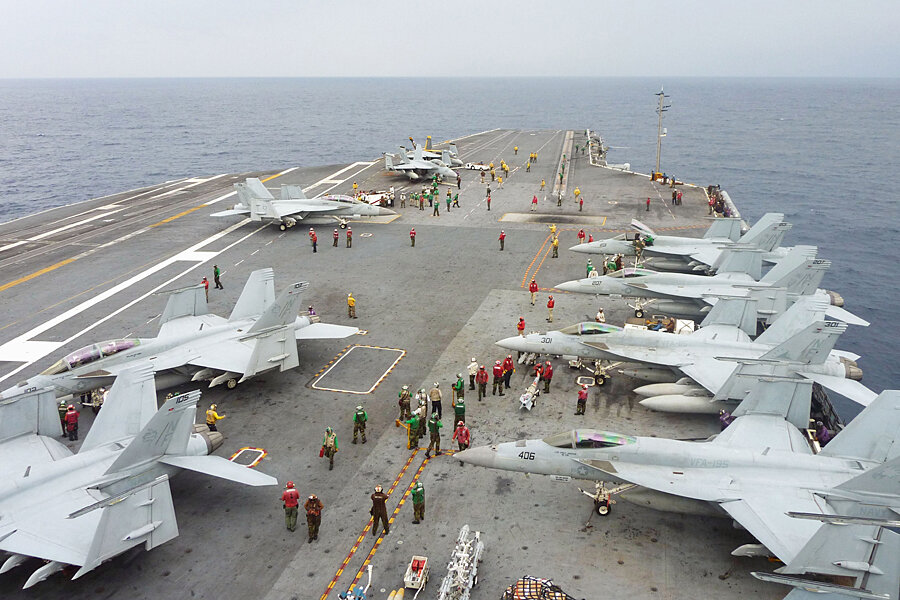USS Cowpens: Why China forced a confrontation at sea with US Navy
Loading...
| Washington
Reports that a Chinese navy vessel tried this month to force a US warship to a halt in international waters have senior US officials and longtime Asia analysts asking what, precisely, China was trying to prove by the maneuver.
US naval officials note that the USS Cowpens – a guided missile warship – was “lawfully operating” in waters near the South China Sea when it had an encounter with a People's Liberation Army (PLA) vessel “that required maneuvering to avoid a collision,” according to an article in the Washington Free Beacon.
The incident followed China’s announcement that it will establish an air defense identification zone (IDIZ) in the East China Sea, a move that elicited howls of objection from the US military, as well as from China’s neighbors in Southeast Asia, who worry about Beijing's growing willingness to flex its military muscle in the region.
While US Navy officials confirm the episode, they also caution that these sorts of standoffs with China happen with relative frequency in the Pacific and that, according to one Navy officer with knowledge of the event, it’s important not to “overhype” the incident.
That said, the recent run-in holds a larger message, analysts say. The chief one may be that the US will not be able to comfortably troll the waters of the western Pacific.
“The Chinese are trying to make it clear that, if the US wants to operate in these waters, then it should be prepared to be operating under a high state of tension,” says Dean Cheng, senior research fellow for Chinese political and security affairs at the Heritage Foundation. “If the US doesn’t want tension, then it’s very simple: leave.”
The confrontation, he adds, was “a deliberate effort to intimidate.”
If this is the case, then to what end? After all, a majority of elites in China prefer to strengthen the bilateral relationship with the United States rather than to pursue "hawkish," hegemonic ambitions, according to a recent report from Michael Swaine, senior associate at the Carnegie Endowment for International Peace.
One possible answer is that recent PLA moves indicate that the “Chinese are now trying to establish a much greater presence in the western Pacific,” says Dr. Swaine. “In a sense, they want to convey to other countries that they are out there, they’re operating, and other people need to recognize this and abide by their desires.”
The USS Cowpens was conducting surveillance of China’s new aircraft carrier, the Liaoning, at the time. According to the Washington Free Beacon, a Chinese ship that was accompanying the carrier moved in front of the Cowpens to try to make it come to a full halt – hardly a safe maneuver. The bottom line is that China is out “to make sure that the US shows respect to China – that they acknowledge a sphere of influence,” says Patrick Cronin, senior director of the Asia-Pacific Security Program at the Center for a New American Security. [Editor's note: The original version of this paragraph did not list the correct organization with which Dr. Cronin is currently affiliated.]
For this reason, he adds, “China’s military posture is increasingly assertive.”
But that doesn’t mean the PLA “is devoted to taking over the western Pacific and ejecting the US,” says Swaine.
More likely, China is interested in establishing greater ability to deter other forces – including Japan and the US – ”from being able to prevail in possible confrontations over Taiwan and other disputed territories,” he says.
In other words, says Swaine, China wants to make it “much more difficult for the US and Japan to be confident that they can use military coercion or force to try to deflect Chinese behavior or threaten China in some way.”
And while “it’s probably true that China doesn’t have imperial ambitions, on the other hand it’s imperious,” Dr. Cronin says.
The net result, Cronin adds, could be that China is behaving in a way that increasingly coalesces an anti-China faction – "the very one that China is purporting to be trying to guard against."







